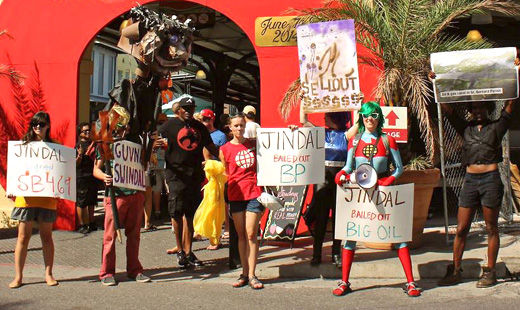
Beginning June 20 and ending June 28, Louisiana citizens and environmental activists staged a 155-mile march from Grand Isle to Baton Rouge. The event was in protest of the continuous poisoning of the state’s water by the ever-greedy oil and gas industries.
The march was prompted when Gov. Bobby Jindal, R.-La., signed SB 469 into law earlier this month. The bill was a direct reaction to a lawsuit filed against 97 oil and gas companies by the South Louisiana Flood Protection Authority (SLFPA), which correctly asserted that oil and gas canals and pipelines have destroyed much of the Louisiana coastal lands. SB 469 would prohibit certain state groups, like the SLFPA, from filing such lawsuits, effectively saving the skins of oil and gas execs – or so many state Republicans had hoped.
On the first day of the march, June 20, the Louisiana Levee Authority in New Orleans voted to allow the SLFPA to continue pursuing the lawsuit, overriding the bill’s authority and giving the group another chance at forcing fossil fuel corporations to own up to the damage they have caused.
With that spark to ignite their enthusiasm, the marchers began the long trek, marching along Louisiana Highway 1. The journey was largely a team effort. Environmental and civic activist Mike Stagg, who organized the event, told the People’s World that the walkers had no formal support from any environmental group for the march itself, but each of the participants are active members of groups ranging from the Louisiana Bucket Brigade to Restore Louisiana Now (RLN) to 350.org to the GreenARMY.
The march culminated in a June 28 demonstration – the Flood Into Baton Rouge – at Gov. Jindal’s mansion. Stagg noted, “The Flood Into Baton Rouge, which is where the march ended, had support and participation from a number of environmental groups including the Gulf Restoration Network, the Louisiana Environmental Action Network, and a number of other local grassroots environmental action groups from across south Louisiana.” He stated he considered the march to be a success, both on the local and national level. “Most importantly,” he said, “we advanced the ongoing coastal conversation about land loss, rising seas, and who will pay for coastal restoration – if it gets done at all.”
While SB 469 will certainly prove to be a roadblock in future efforts by state groups to fight the crimes of oil and gas companies, RLN president John Barry remarked, “Although the legislative battle is over, the war isn’t. To quote the classic words of John Belushi, ‘It ain’t over ’till it’s over.'” Meanwhile, he said, “is there a single person in Louisiana who believes the governor is putting the state’s interest ahead of his personal ambition? At last count, 106 legal scholars warned that signing the bill would put at risk claims against BP” for damages done during the 2010 Deepwater Horizon oil spill. “The attorney general, the president of Jefferson Parish, the New Orleans City Council, and others all called upon the governor to veto the bill. I think he signed it because they were just the beginning of a broad chorus from around the state, and he wanted to cut that off before the chorus became deafening.” And this bill, moreover, will affect future claims against BP and other oil corporations, he added, “if, for example, a pipeline ruptures in the coastal zone.”
The march and Flood Into Baton Rouge, Stagg added, were very much intended also to draw attention to Jindal’s signing of SB 469. “The bill was so hastily drawn and poorly written that it might jeopardize the state’s share of the BP environmental damages resulting from the 2010 Gulf gusher,” he said. “The stated purpose of the legislation was to retroactively kill” the SLFPA’s lawsuit, which was “insane enough.” But even worse, he noted, was “their rush to spare the most profitable industry in the history of the world the legal liability growing from their actions.”
The aftermath of that catastrophic BP spill is still being felt today, and is just one of the many reasons for the marchers’ push for clean water and coastal reparations.
Doug Inkley, senior scientist at the National Wildlife Federation, remarked, “Years after the initial explosion, the effects of the BP disaster continue to unfold.” A recent study by the group found that the Gulf toxicity is still having a severely negative effect on the wildlife populations there – and particularly on dolphins. “These ongoing deaths, especially in an apex predator like the dolphin, are a strong indication that there is something amiss in the Gulf ecosystem.”
Sacrificing the state’s ability to hold BP accountable for such devastation, many feel, is unjustifiable. Stagg concluded, “Louisiana has a long history of making environmental trade-offs. So many of these trade-offs have been made that the cumulative effects have not been considered. Those effects are clear now and we cannot afford to continue down the path that has brought us here.”
Photo: “Go Captain Planet” Tumblr page

MOST POPULAR TODAY


Zionist organizations leading campaign to stop ceasefire resolutions in D.C. area

High Court essentially bans demonstrations, freedom of assembly in Deep South

Afghanistan’s socialist years: The promising future killed off by U.S. imperialism

Communist Karol Cariola elected president of Chile’s legislature






Comments